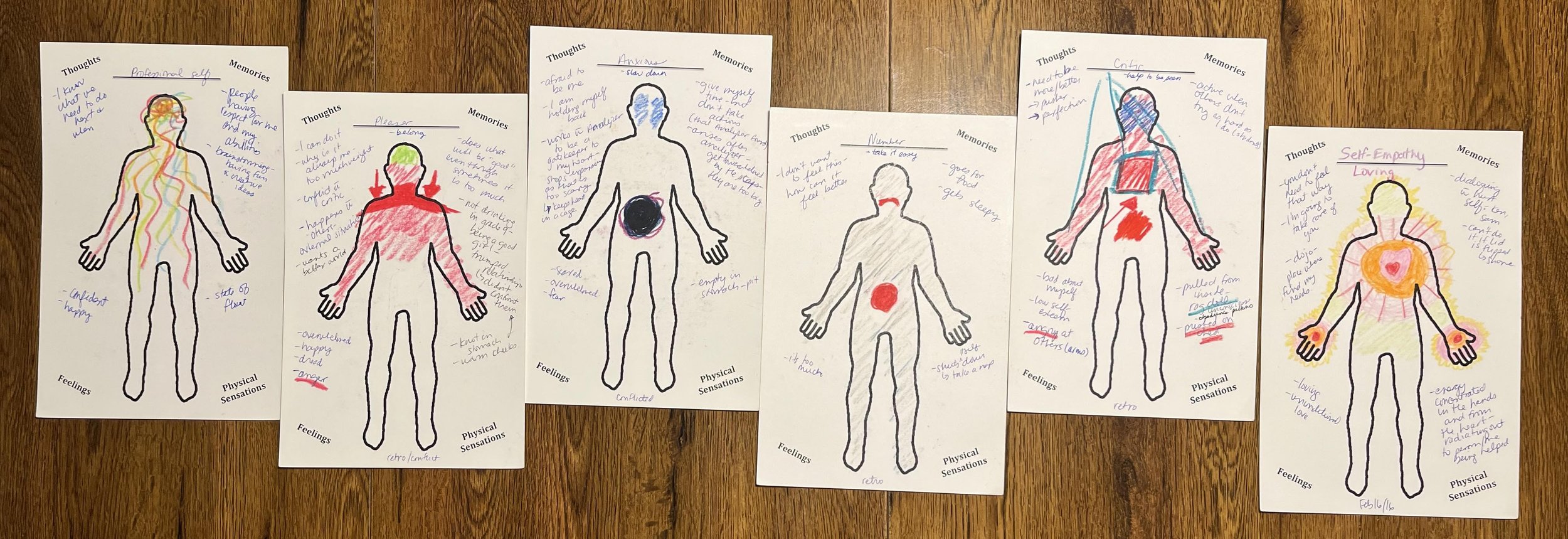Adding self-compassion to the Focusing Attitude
This blog follows a blog that describes the Focusing Attitude, as part of three things that helped me better understand Gendlin’s Focusing book.
Bringing more heart energy to the focusing attitude
A recap from the last blog that the Focusing Attitude is a way of being friendly, welcoming and nonjudgmental with ourselves. You can read more in the last blog.
More recently I have been drawn to describing the focusing attitude with “open mind, open heart, and open will” or “curiosity, compassion, and courage”, strings of terms that come from Otto Scharmer’s work in Theory U and presencing. And I’ve been especially drawn to brining more heart energy into Focusing practice.
My journey with self-compassion
My main reason for being drawn to using more compassion, is knowing that it’s been very important and helpful in my own personal experience. My journey to having more self-compassion (see a video explainer) has felt like it was a major turning point in my healing. I knew internally that I was there for myself!!
In 2015, I did a self-love project with myself. It was part of a Focusing on Borden course that got to know our parts. I learned more about my critic, my adventurous self, my anxious self. But most importantly, I got to know my self-empathy and compassionate self—see my body card from an exercise the following year of where I feel this part in my body. At some point I realized that compassion is the word for doing (vs empathy for feeling), and took to calling this part self-compassion.
In mapping and identifying self-compassion, it began to be a more regularly part of my life. I could call upon it. Pull it “on stage” so to speak.
You see, my critic used to have a pretty loud voice in my head. Often it showed up as a perfectionist, urging me onward. Other times, there was a pleasing part of me that would over-extend myself. When I called on self-compassion more, things started to change.
A regular example was in those over-extended times (usually where my professional self had gotten overwhelmed by my pleaser part that took on too much) , I’d find myself walking to get a slice of pizza for dinner, not having the energy to cook. This would be done by my “number”, a fixate part, as in the one that gets me numb with food (or other things) by propelling me from a stressed fight/flight place in my nervous system to a numb place after eating the pizza (see Jan Winhall for more on bad habits and addiction, including addictive shifts). My critic would say “you’re wasting money, you’re lazy, you’re making unhealthy choices.” And then I’d ask my self-compassion what it thought, and it would say “you’ve got too much on your plate…. let’s sleep in on Saturday and book some self-care.”
Felt sense body cards that illustrate the parts of me that used to be stuck in a loop of doing too much, and then needing to soothe, and how self-compassion overtime reduced the need for both the critic and more recently the pleaser.
I made a practice of calling on self-compassion to see what it had to say when I noticed my critic, and month after month, things began to change. Eventually, self-compassion was the only one to show up in those instances. The critic was no longer needed if I felt like eating pizza.
That’s not to say my critic never shows up. It still does, though infrequently. For example, if I do something really silly, or stupid even, I will sometimes have a critical thought. But I can see a shift there too. In the past, I would have been mean to myself, berating myself. Now, when that voice shows up I’m no longer threatened by it. Instead, I can laugh at it and say: “Hello critic, nice to see you!”
Since then, my self-compassion has also helped me not over-commit by having stronger boundaries about how much work is healthy for me to take on, significantly reducing the use of my pleaser part and consequently the stress of taking on too much.
How does self-compassion help us?
I understand it as moving from being witnessed and co-regulated by our focusing partner, to being able to be self-regulating, or maybe more precisely co-regulating something in us that is hurt (a wounded part) with our self-compassion (Self quality). And that this is something that was possible for me as I have “had many opportunities to co-regulate with others” in the past. Our work with focusing partners or a professional listener helps us build that resource within us.
The reason having self-compassion might feel so good to me is possibly explained by the research of Dr. Kristin Neff and others that shows we get a hit of oxytocin. There is also the HeartMath Institute’s research, which shows that when we are experiencing compassion (or appreciation or love) that we have a coherent heart rhythm pattern, which is characterized by a smooth, sine-wave-like waveform. This is called heart coherence and is the harmony between our mind and body. In contrast, the wave of a state of relaxation is not as regular, and a state of frustration is jagged!
Ways to activate self-compassion
I’ve experimented with incorporating more heart energy into centerings, mostly by adding some heartfelt presence into my adaptation of David Rome’s Grounded, Aware, Presence. The practice includes three parts, learned from three different sources:
first, we place one hand on the heart and the other on our cheek. (I learned this from Jan Winhall. This activates the ventral vagus nerve by touching it in our heart space and face. This is the flock part of our nervous system as named in her Felt Sense Polyvagal Model™)
second, we tilt our head, to lean our cheek into the supporting hand (the tilting of our head sideways is part of activating a tenderness energy via Alba Emoting, learned from Sergio Lara)
third, we do heart-breathing, imagining that our breath is flowing in and out of our heart as we breath (this comes from the Quick Coherence® Technique of the HeartMath Institute)
Adding this heart energy into centerings is a way of practicing step six of Focusing: Receiving as a preparatory step, rather than just when something difficult comes. You can experience my version of Grounded, Aware, Presence in the video below:
This video is from a presentation to The EMDR Learning Community.
8:45 - Grounded Aware Presence centering (my adaptation of David Rome’s lovely practice. You can also read more about it above in this blog, where I outline the pieces to activating more heart energy in centering)
17:32 - Guided Focusing experience
Benefit of adding heart energy to inner work
The experiment of adding more heart energy seems to deepen student’s experiences. They seem able to do that work of being with their inner child quite directly, rather than needing to spend significant time on protector parts (this is my recollection… I haven’t kept track in any formal way). My impression on the importance of working with self-compassion energy first, is shared by Deborah Lee. In a NICAMB video she says (italics added are mine):
And this is really important that we bring the compassionate system online first before we invite the trauma memory to the conscious mind that relives it. It’s really important because that’s when you can keep it engaged and it can do its work.—Deborah Lee, DClinPsy
Other ways to cultivate self-compassion can be using archetypes—real or imagined. Here are three ways to access these self-compassion supports that I learned via NICAMB: perfect nurturer (see NICAMB video of Deborah Lee, DClinPsy, explaining the use of this imagery exercise with a client), compassionate image or compassionate other (see this recording of Paul Gilbert leading an exercise), or caring committee (Rick Hanson’s term; his include the fairy godmother from Sleeping Beauty and Gandalf).
More research is needed
I hope more research will be done in future on how self-compassion affects the focusing attitude and focusing more broadly. For now, we know from Laury Rappaport that the focusing attitude both cultivates and deepens self-compassion (see her chapter in a book she also edited Mindfulness and the Arts Therapies Theory and Practice). That reflects my personal experience of my self-compassion growing as I practiced using the focusing attitude in focusing.
Perhaps a key gift of the focusing attitude is it is a bridge from being defensive, self-critical and overrun by the inner critic, to becoming self-compassionate. In other words, maybe the focusing attitude can begin without self-compassion, starting with friendliness and curiosity for example, and then grow into the more action oriented doing to alleviate suffering that is self-compassion.
I’d also like to see some research on the role of courage in Focusing. When we can spend some time being open to whatever is there, that in my mind is both very curious and courageous. As Mia Leijssen says in Focusing Microprocesses:
However, many clients offer resistance because they experience this inner process as threatening. This attitude presupposes tolerance for uncertainty, an ability to give up control and to be vulnerable, since neither the therapist nor the client can anticipate what will emerge from the implicit. Not knowing exactly what is going to emerge is very frightening to people who have been used to keeping emotions down and under strict control.
Overtime, we can learn to find a “safe place inside” as Gendlin says. And then working with a focusing partner, coach or therapist we can eventually have the courage to go there. As Jan Winhall says, “Can you welcome the uncomfortable?” To be in our bodies, to be heart-centered, and to embrace being kind towards ourselves, to be with what needs our attention.
Bring more self-compassion to your focusing attitude
Are you wanting to work on your focusing attitude and self-compassion? I invite you to join one of my 8-week courses that really explore this work:
Understanding who you are: mapping your nervous system, parts and timeline: In this course, we explore our autonomic nervous system, and better get to know our grounded, hurt and protective parts with felt sense body cards. Our first three weeks are spent building our focusing attitude to do this work.
Creating your Special Project: a TAE exploration of Focusing and You: In this course, we give a lot of space for the felt sense to form and speak to us. It creates a very gentle welcoming in our focusing attitude. We also learn Gendlin’s second practice, Thinking at the Edge.
Transform Yourself with the 8Cs of Self-Leadership: The course is designed to either work through one large issue, week-by-week, or you can bring a new issue each week. We do so with the resourcing of that week’s “C” quality energy, which include self-compassion, and other qualities like calm, curiosity and confidence. Overall, the experience strengthens your access to your focusing attitude with much more detail for each energy.
In our safe shared space, we will better get to know our self-compassion and use it to hold space for each other and our felt senses to change, one felt shift at a time. Not ready for a course yet, begin with the on-demand recording of our workshop Grow access to your Self. Or take a beginner Focusing course or workshop, which is a pre-requisite for the below courses.






